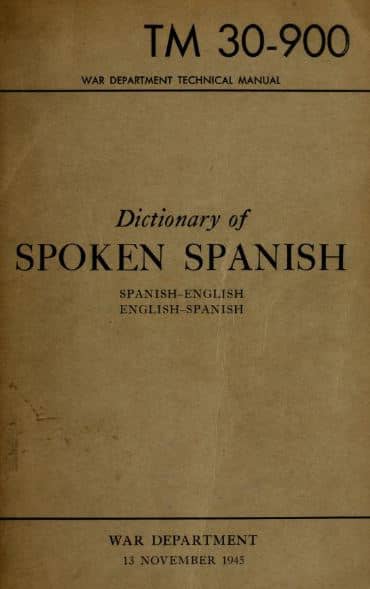‘Dictionary Of Spoken Spanish’ PDF Quick download link is given at the bottom of this article. You can see the PDF demo, size of the PDF, page numbers, and direct download Free PDF of ‘Dictionary Of Spoken Spanish To English’ using the download button.
Spoken Spanish Guide PDF Free Download

Dictionary Of Spoken Spanish: Spanish-English, English-Spanish
A single consonant sound (and, in writing, two letters representing a single sound), or a consonant followed by I or r, belongs to the same syllable as the vowel following it: ca-ro, ca-rro, mi-lla.
Other groups of two consonants are broken up, the first consonant belonging with the preceding vowel and the second with the following vowel: juz-qar “to judge”; rec-tor “rector”.
0.4 Stress. Words ending in a vowel or in – or -8 are normally stressed on the next to the last syllable; words ending in any other consonant are stressed on the last syllable.
Words having this type of stress bear no written accent mark: cosa “thing”; cantan “they sing”; cantas “you sing” (Fam); cantar “to sing”.
If a word does not conform to this pattern, an accent mark is written over the vowel letter of the syllable which is stressed: vdmonos “let’s go”; jardin “garden”.
In a few cases, a written accent serves only to mark the difference between one word and another written like it but having a different meaning: cudndo? “when?” (interrogative), but cuando “when” (relative).
When the pronouns mé, 14, and si (ag) are used as objects of the preposition con “with”, the result of the following form: conmigo, contigo, and consigo.
The word usted (abbreviated Ud. or Vd.) is used when speaking to persons with whom one is not well acquainted, and takes a verb in the third person singular; the plural ustedes (abbreviated Uds, or Vda.) is used in the same way.
In Spanish America, ustedes is often used instead of rosotros, as the plural corresponding to tú.
Ta is used only between relatives, young people, intimate friends, and in addressing children, servants, and pets. In South America, especially Argentina, cos is generally used for ta.
When used before a noun or noun phrase (ef $2.14.1), el, la, ete, have about the meaning of English “the”, and in this use are termed the definite article.
The form el is used before a masculine singular noun or noun phrase: el hombre “the man”, el gran diccionario “the great dictionary and also directly before.
a feminine noun beginning with the stressed sound a: el alma “the soul”, el hambre “the hunger” Before other feminines, la is used: la persona “the person”, la otra persona “the other person”.
In the plural, los is used before masculine and las before feminine nouns or noun phrases; los hombres “the men”, los grandes diccionarios “the great dictionaries”, las almas “the souls”, las otras personas “the other persons”.
1.23 Interrogative pronouns are: que “what?”, quién? “who?”, quiénest (pl), 4de quién? “whose?”, de quiénes (pl), ¿cudl? “which one?”, tudies?
“which ones?”, ¿cuánto “how much?”, cuántos? “how many?” All interrogative adjectives and pronouns bear a written accent mark to distinguish them from the corresponding relative.
qué is not inflected. ¿de quién? is always followed immediately by ser: De quién es este librof “Whose book is this?”
When translating from English into Spanish, the interrogative de quién? should not be confused with the possessive relative cupo “whose, of which”
“This book, whose influence has been so beneficial.” Ese libro, cuya influencia ha sido tan beneficiosa. But Whose book is this?” ¿De quién es este libro?
1.24 Relative pronouns are que “that, which, who”, quien, quienes “who, whom”, el que “he who, the one who, the one which, that which”,
la que “she who, the one who, the one which, that which”, lo que “that which, what”, los que those who, those which”, las que those who, those which”,
el cual, la cual “he who (she who), the one who, that which”, Los cuales, las cuales “they who, the ones who, those which”, lo cual “that, which, what”, cuanto “all that, as much as”, chantos “all that, as many as”.
A simple relative (1. below) has an antecedent in the main clause and the compound relative (2, below) contains its own antecedent. This distinction concerns the use and not the form.
| Author | War Dept |
| Language | Spanish |
| No. of Pages | 513 |
| PDF Size | 34.1 MB |
| Category | Dictionary |
| Source/Credits | archive.org |
Related PDFs:
Dictionary Of Spoken Spanish PDF Free Download
